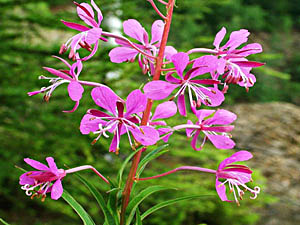
medicinal herbs
Willow Herb
Epilobium angustifolium

Herb: Willow Herb
Latin name: Epilobium angustifolium
Synonyms: Chamaenerion angustifolium
Family: Onagraceae (Evening Primrose Family)
Medicinal use of Willow Herb:
Willow herb is often used as a domestic herbal remedy, though it is little used in conventional herbalism. The herb is antispasmodic, astringent, demulcent, emollient, hypnotic, laxative and tonic. It is used in the treatment of diarrhoea, mucous colitis and irritable bowel syndrome. The plant is used in Germany and Austria to treat prostate problems. A poultice of the leaves is applied to mouth ulcers. An extract of the leaves has anti-inflammatory activity. An ointment made from the leaves has been used to soothe skin problems in children. A tea made from the leaves and roots is a folk remedy for dysentery and abdominal cramps. A poultice made from the peeled roots is applied to burns, skin sores, swellings, boils etc.Description of the plant:

Plant:
Perennial
Height:
2 m(6 1/2 foot)

Flowering:
July toSeptember
Habitat of the herb:
Rocky ground, waste areas, woodland edges and gardens.Edible parts of Willow Herb:
Leaves and young shoot tips - raw or cooked. They can be used in salads or cooked as a vegetable. When boiled they make a wholesome vegetable and are a good source of vitamins A and C. Only use the leaves when they are young. Although they are said to be edible, another report says that an infusion of them can stupefy. Young shoots - cooked. They make a good asparagus substitute. Root - raw, cooked or dried and ground into a powder. Used in spring, it has a sweet taste. Flower stalks - raw or cooked. Added to salads, they are used when the flowers are in bud. The pith of young or older stems - raw or cooked. Slightly sweet, tender and pleasing to eat, though there is not much of it. Gelatinous, it can be used as a flavouring in soups. The stems are said to be a good laxative, but are best not eaten on an empty stomach. A tea is made from the dried leaves, it is sweet and pleasant. Called "kaporie" tea in Russia, it contains 10% tannin. The leaves are also used as an adulterant of China tea.Other uses of the herb:
A fibre obtained from the outer stems is used to make cordage. The "cottony" seed hairs are used as a stuffing material or as a tinder. The powdered inner cortex is applied to the hands and face to give protection from the cold.Propagation of Willow Herb:
Seed - sow early spring in situ or as soon as the seed is ripe. This plant is more than capable of finding its own way into most gardens and does not usually require an invitation. Division in spring or autumn. Very easy, larger clumps can be replanted direct into their permanent positions, though it is best to pot up smaller clumps and grow them on in a cold frame until they are rooting well. Plant them out in the spring.Cultivation of the herb:
Rocky ground, waste areas, woodland edges and gardens.Known hazards of Epilobium angustifolium:
An infusion of the leaves is said to stupefy a person.Plant information taken from the Plants For A Future.
